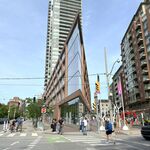3Dementia
Senior Member
to attract outsiders ... or invite...
Boy, these are some of the least valid reasons to hate CityPlace I've heard on these forums, and I'm not even a fan of the development.City Place lacks this accessibility to other destinations except China Town, the waterfront (is this really a destination?) and the sports complexes (Rogers, ACC and the Ex). Once the streetcar comes in along Fort York and the surrounding area is built a sence or belonging and completion should take hold around City Place. As an island on its own, it comes up short. The lack of transit connectivity and proximity to other established "lived-in" areas adds to City Place's failure.
I can't seem to find a clear, large, good quality render of what the entire development will look like from the air. (That includes the big park and new streets). Anyone have one?

Boy, these are some of the least valid reasons to hate CityPlace I've heard on these forums, and I'm not even a fan of the development.
Of all the failures Cityplace represents, location really isn't one of them.
lots of words
I would agree to your arguement applied to everything west of Spadina (and even then, only those not immediately attached to Spadina, like Parade, Luna, and any dwellings closer to Bathurst). That side is definitely an island.
For the eastern half, however, your transit isolation arguement has a hole in it the size of a Spadina streetcar. I also think people tend to greatly overstimate the distance from Wellington, Front, and maybe even King St, psychological or otherwise, where you'll find some of the city's best established areas.
Sorry if these questions have already been answered, but...
Will Bremner act as a main thoroughfare between Spadina and Bathurst?
If so, will a streetcar line go down the center of Bremner to create a loop effect between the Spadina and Bathurst cars?
(And thanks Avatarreb for the render).




